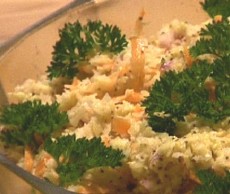Cole Slaw – Gluten Free
Wednesday, December 31st, 2008We had a ball during the Christmas festivities. I had opportunity to sample and enjoy many tasty foods. I’m happy to report, that despite the many temptations at hand, I restrained myself admirably and had just enough to feel nicely satisfied. In the past I’ve tended to really “pig out” and regret not being more conservative.
 One of the dishes we prepared for the family feast was Cole Slaw. This will be the subject of today’s post.
One of the dishes we prepared for the family feast was Cole Slaw. This will be the subject of today’s post.
Background:
Did you know that Coleslaw (or Cole Slaw) is believed to have been consumed since early Roman times? (…..I guess you’d expect as much, seeing that cabbages have been around a long time  ).
).
The version with a creamy dressing, or mayonnaise, would not have been developed till the 18th century, as mayonnaise was not invented till then.
It’s name arose in the 18th century as a partial translation from the Dutch term “koolsalade” or “cabbage salad”. “Cole” in Latin originates from “colis”, meaning cabbage. Cabbages also have many healing properties some of which particular affect the digestive function, including the colon. Interesting eh!?




 Continuing on from the last post, here are a few pointers to help you find the kind of raw materials you need to make the delicious porridge mentioned
Continuing on from the last post, here are a few pointers to help you find the kind of raw materials you need to make the delicious porridge mentioned 
 it’s just that you want a CHANGE every now and then. You know what I mean?
it’s just that you want a CHANGE every now and then. You know what I mean? On a couple of occasions we’ve been asked about how to make gluten free baked products lighter (we understand that “door-stop bread loaves” are just not the fashion any more); and how to make your own self-rising flour for use in gluten free cooking.
On a couple of occasions we’ve been asked about how to make gluten free baked products lighter (we understand that “door-stop bread loaves” are just not the fashion any more); and how to make your own self-rising flour for use in gluten free cooking. 
